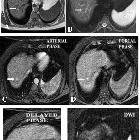Dysplastic liver nodules
 ähnliche Suchen
ähnliche SuchenDysplastic liver nodules are focal nodular regions (≥1 mm) without definite evidence of malignancy.
Epidemiology
They have been found in cirrhotic patients with a prevalence of 14% (size >1.0 cm) to 37% (size >0.5 cm) .
Associations
Pathology
Dysplasia indicates:
- nuclear atypia
- increased fat or glycogen in the cluster of dysplastic cells
Classification
They are broadly divided depending on the presence of cytologic and architectural atypia :
- low-grade: resemble regenerative nodule
- high-grade: resemble well-differentiated hepatocellular carcinoma (HCC)
- atypia is insufficient to establish a diagnosis of HCC
- may exhibit clone-like features
Radiographic features
Ultrasound
Cirrhotic changes are present but the nodules may not be visualized on ultrasound. A few cases have shown hypo- and hyperechoic nodules and the echogenicity relates to the fat content in the nodule.
CT
Usually hypoattenuating, however, they may be iso- or hyperattenuating to the hepatic parenchyma.
- multiphase contrasted images: they may show early arterial uptake but the contrast does not wash out on delayed phase (unlike HCC)
MRI
- T1: although the signal intensity may vary broadly, most of them have high T1 signal
- IP-OOP: shows fat accumulation characterized by signal drop on the out-of-phase sequence
- T2: iso- to hypointense
- DWI: no restricted diffusion
- T1 C+ (Gd)
- high-grade nodules show early contrast enhancement without washout on delayed phase
- T2* C+ (SPIO)
- low-grade nodules appear hypointense
Treatment and prognosis
They are considered premalignant and hence follow-up is necessary. Percutaneous ablation therapy can be considered .
Differential diagnosis
- regenerative nodule
- early hepatocellular carcinoma
- increased T2 signal
- restricted diffusion
- washout on multiphase postcontrast imaging
Siehe auch:
und weiter:
 Assoziationen und Differentialdiagnosen zu dysplastische Leberknoten:
Assoziationen und Differentialdiagnosen zu dysplastische Leberknoten:




